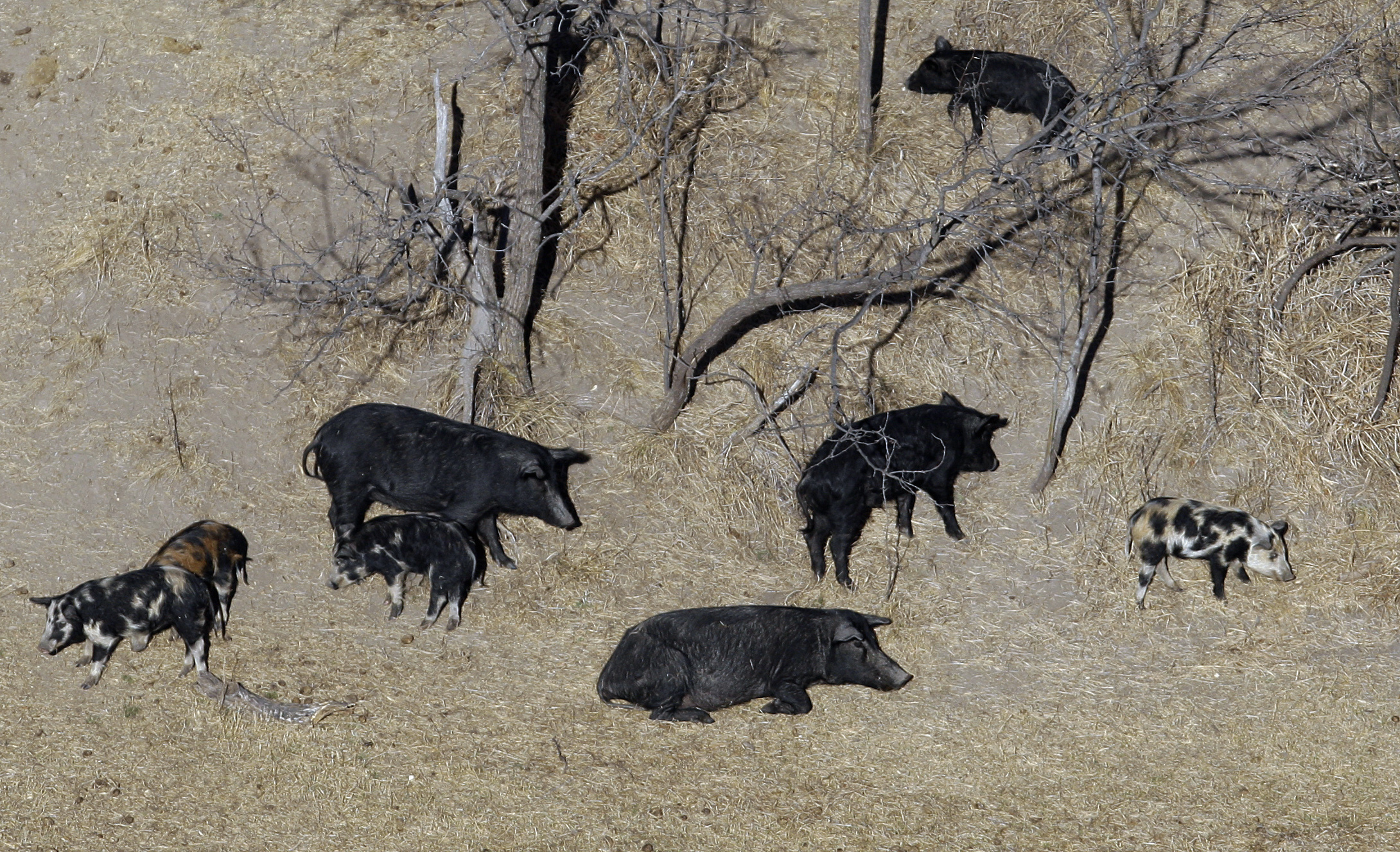America's pig problem
Dozens of states are being overrun by aggressive feral hogs. Can they be controlled?

How many feral hogs are there?
Their population has exploded to an estimated 6 million across 39 states, with the greatest concentration in the South, particularly Texas. Feral hogs — also known as wild boars, wild pigs, and "razorbacks" — are prodigious breeders, have few natural predators, and are voracious, causing $2.5 billion in damage to farms and ecosystems annually. Like all pigs, the feral variety are omnivores and will devour anything they can tear up with their long snouts and 6-inch-long, razor-sharp tusks, including crops, gardens, frogs, worms, eggs, and even deer and lambs. They favor plants, and 50-pig herds, or "sounders," can empty whole fields of corn or wheat overnight. The invasive species has spread far and wide largely because it is well adapted to its environment and breeds so rapidly, with ranchers and hunters making the problem worse by trucking wild hogs into new areas so they can be shot for sport. Hunting them to control their population hasn't worked: You'd have to shoot 70 percent of the feral pig population every year just to keep it static.
Where did the hogs come from?
The Week
Escape your echo chamber. Get the facts behind the news, plus analysis from multiple perspectives.

Sign up for The Week's Free Newsletters
From our morning news briefing to a weekly Good News Newsletter, get the best of The Week delivered directly to your inbox.
From our morning news briefing to a weekly Good News Newsletter, get the best of The Week delivered directly to your inbox.
Their roots on this continent can be traced to Spanish conquistador Hernando de Soto, who brought black Iberian pigs to America around 1540. The pigs flourished in the New World, with some escaping to create a feral population. These wild pigs would later crossbreed with Eurasian wild boar brought into the U.S. for hunting in the 1890s and 1930s, producing what Canadian animal science professor Ryan Brook calls "a super pig" — weighing 200 to 500 pounds, capable of running up to 30 mph (or faster than sprinter Usain Bolt), and equipped with a wily intelligence that enables them to learn from their experiences. "They're one of the smartest animals on the planet," says wildlife biologist Alan Leary. They're also among the most prolific: Female hogs, or sows, begin breeding at around 6 months old and crank out two litters of four to 12 piglets every year. The hogs live five to eight years and are adapting to more northern climates, with their thick fur letting them migrate toward Canada. They've also learned to keep warm in colder states by burrowing into the snow to create "pigloos."
Are they a threat to humans?
Feral hogs are nocturnal and rarely attack people, although in the predawn darkness last November, wild pigs attacked Christine Rollins, 59, in rural Texas and bit her to death. New York Mets slugger Yoenis Cespedes missed all of last season after a wild boar lunged at him on his Florida ranch, causing Cespedes to step into a hole and break his ankle. Hogs are mostly feared, however, for their indiscriminate eating; researchers have cut open a dead hog's stomach and found it bursting with baby sea turtles. One study found that mammals and birds are 26 percent less diverse in forests with feral pigs. With no sweat glands, hogs wallow in water to cool off, introducing pathogens to water systems. They can carry at least 32 diseases, and scientists have blamed E. coli outbreaks on feral hogs defecating in spinach and lettuce fields. "Generally, an invasive species is detrimental to one crop," said Dale Nolte of the Department of Agriculture. "Feral swine are destructive across the board."
Can their population be controlled?
A free daily email with the biggest news stories of the day – and the best features from TheWeek.com
All efforts to curtail the hog invasion have thus far been futile. Congress included $75 million in the 2018 Farm Bill for "feral swine eradication," but actually wiping out the South's millions of pigs is widely considered impossible. In desperation, Texas — which has 2 million wild hogs — passed a law last year allowing people to shoot the marauders without a hunting license, and the state allows hog hunting year-round and without individual limits. Countless videos on YouTube show hunters on trucks or in helicopters blasting one scurrying pig after another like targets in an arcade game. Some ranchers even use bombs to blow up groups of hogs. Still, the wild hog population grows.
Can they be eaten?
Ranchers do trap feral pigs and sell them in Oklahoma and Florida to government slaughterhouses, which sell the pork cheaply. Many Southern restaurants are trying to make use of the excess meat, especially from sows and young boars. At his restaurant outside Austin, chef Taylor Hall only has to pay $35 per feral pig. The meat is very lean and has an intensely gamey flavor, but when mixed with fattier domestic pork to make a ragù for pasta, "it can be absolutely fabulous," Hall said. Unfortunately, pork-loving Americans can't solve the country's "greatest emerging wildlife challenge," said John Mayer, a government biologist in South Carolina. "We're not going to barbecue our way out of this one."
The threat of African swine fever
The U.S. is one of the few major pork producers unscathed by African swine fever, which is spreading throughout southeast Asia and eastern Europe. American pork is being shipped in record amounts to China, where African swine fever has already killed at least one-third of the pigs. Countries are frantically insulating themselves, with France building 82 miles of fence to keep wild boar out, and Denmark erecting fencing along its border with Germany. African swine fever doesn't affect humans, but it's highly contagious among pigs and kills them within a few days. The virus can also spread through ticks, manure, knives used to cut carcasses, even farmers' clothing. With a $1 trillion hog sector, China is the world's top pork consumer, and the financial firm Rabobank estimates that China's pig losses are closer to 55 percent. As the world's biggest pork exporter, the U.S. has a lot to lose if the disease reaches these shores, and the Department of Agriculture last year added 60 beagle teams to the 119 it already had sniffing for contraband pork at airports and seaports. "If this gets in," said Dave Pyburn, a scientist at the National Pork Board, "it will destroy our industry as we know it."
This article was first published in the latest issue of The Week magazine. If you want to read more like it, try the magazine for a month here.
-
 How the War Department became the Department of Defense – and back again
How the War Department became the Department of Defense – and back againIn Depth In 1947 President Harry Truman restructured the US military establishment, breaking with naming tradition
-
 Codeword: December 8, 2025
Codeword: December 8, 2025The daily codeword puzzle from The Week
-
 Sudoku hard: December 8, 2025
Sudoku hard: December 8, 2025The daily hard sudoku puzzle from The Week